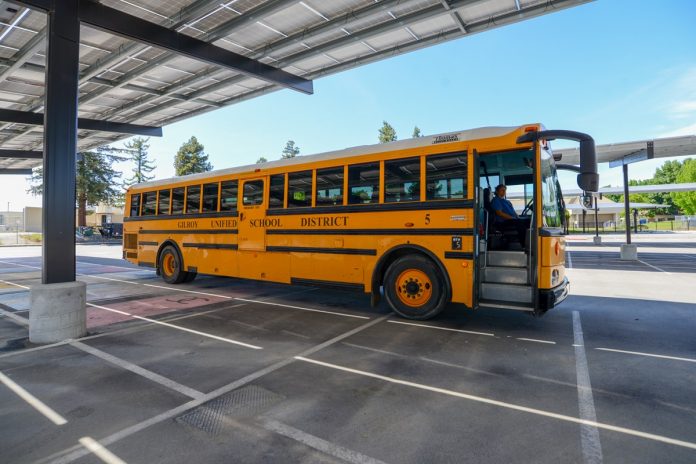Gilroy Unified School District has sent out a group of busses with WiFi capabilities stationed at four school sites for students to have increased internet access.
Busses are stationed in the parking lot at Antonio Del Buono Elementary, Rucker Elementary, South Valley Middle and Gilroy High schools to support distance learning needs.
Alvaro Meza, CBO and assistant superintendent of Business Services, said the Covid-19 pandemic and school closures shifted the way the district provides learning options to students.
“It really has heightened our awareness of the digital divide that exists,” he said. “We want every single student to have access to our distance learning tools. In order to do that we’ve got to reach them.”
Dr. Deborah Flores, superintendent at Gilroy Unified, said the Covid-19 pandemic has shown the employees that the technological divide for families is greater than they thought.
“We are hopeful that by providing free WiFi for our students and families that some of these issues can be addressed,” she said.
Gilroy Unified has distributed 3,428 Chromebooks and now it’s deploying the WiFi hotspots for students with needs. Two busses are capable of blanketing the Gilroy High parking lot with a signal and could accommodate at least 200 cars.
“The key is to keep social distancing and we do ask that they remain in the car because they should be picking up the signal,” Meza said.
According to the California Department of Education, State Superintendent of Public Instruction Tony Thurmond and other state leaders asked that internet service providers offer free guest access to all California students.
On May 4, executives from AT&T, Comcast, Cox Communications, Sprint, T-Mobile and Verizon were asked to provide details on efforts to provide students from low-income and rural communities free or low-cost internet access.
“We can’t assist our students at the level they need without help from all partners,” Thurmond said. “The digital inequities that this pandemic has brought to light for students who are economically challenged and students living in rural communities have to be fixed.”
The busses are hotspots on wheels and that means they can divert one to other locations if needed.
Meza said this is just a temporary solution because it’s not going to work during the hot summer months.
Gilroy Unified is working on getting individual devices at student’s homes. The district has identified 340 families in need of internet access.
Meza said that on May 28 the board will vote on whether or not to move forward to purchase hotspot devices to provide families with free internet.
Once the individual WiFi hotspots are distributed the district will reevaluate where the busses will go.
Meza mentioned that the district wants to make sure all students feel supported during this crisis.
“Our teachers have been doing a great job of maintaining contact with them,” he said. “We want all students to be reached, all 11,000 students, and we know that these 340 families are not being reached right now.”
There are various carriers such as AT&T and T-Mobile that offer free service. But Meza said they know there’s a barrier for some families that might need to wait at least a month to get service installed.
“We can’t just sit idle and wait for a month for our students to get further behind,” he said. “We need to take action now.”
Busses will be available on Mondays, Wednesdays and Fridays from 8-10:45am and from 2-4pm. On Tuesdays and Thursdays, internet access is available from 8-11:30am and from 12:30-4pm.













